Stone brings timeless elegance and natural warmth to bathroom spaces, offering unparalleled textures and hues that elevate both contemporary and classic designs. From dramatic marble veining to earthy fieldstone accents, stone can define focal walls, sleek countertops, and intricate mosaics. This guide presents 20 inspired ways to incorporate stone into your bathroom, balancing functionality with aesthetic impact. Drawing on ideas from leading design authorities, you’ll discover options ranging from polished granite vanities to rustic pebble floors and backlit onyx features. Whether you seek a spa-like retreat or an industrial-chic powder room, these ideas demonstrate stone’s versatility and enduring appeal.
1. Natural Stone Accent Wall
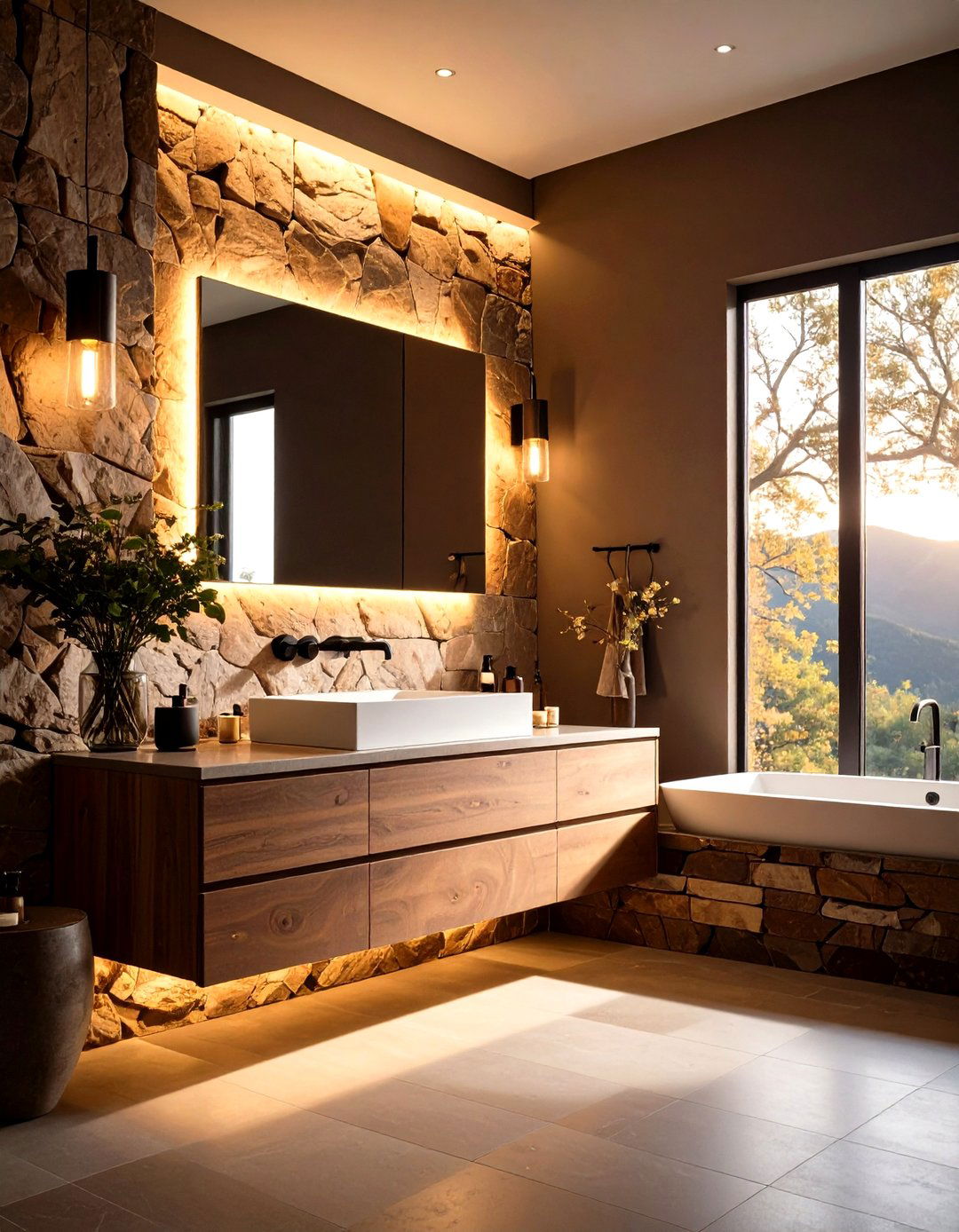
Creating a natural stone accent wall instantly infuses texture and depth, transforming a plain bathroom into a striking retreat. Opt for slabs of marble or quartzite with bold veining to serve as a dramatic backdrop behind the vanity or tub. Pairing the stone wall with minimalist fixtures lets the material’s inherent beauty shine, while under-cabinet lighting highlights its patterns. For a subtler look, choose honed finishes on limestone or travertine that impart a soft, matte appearance. This approach works equally well in modern, rustic, or transitional settings, as the wall becomes the room’s focal point without overwhelming the space.
2. Marble Vanity Tops
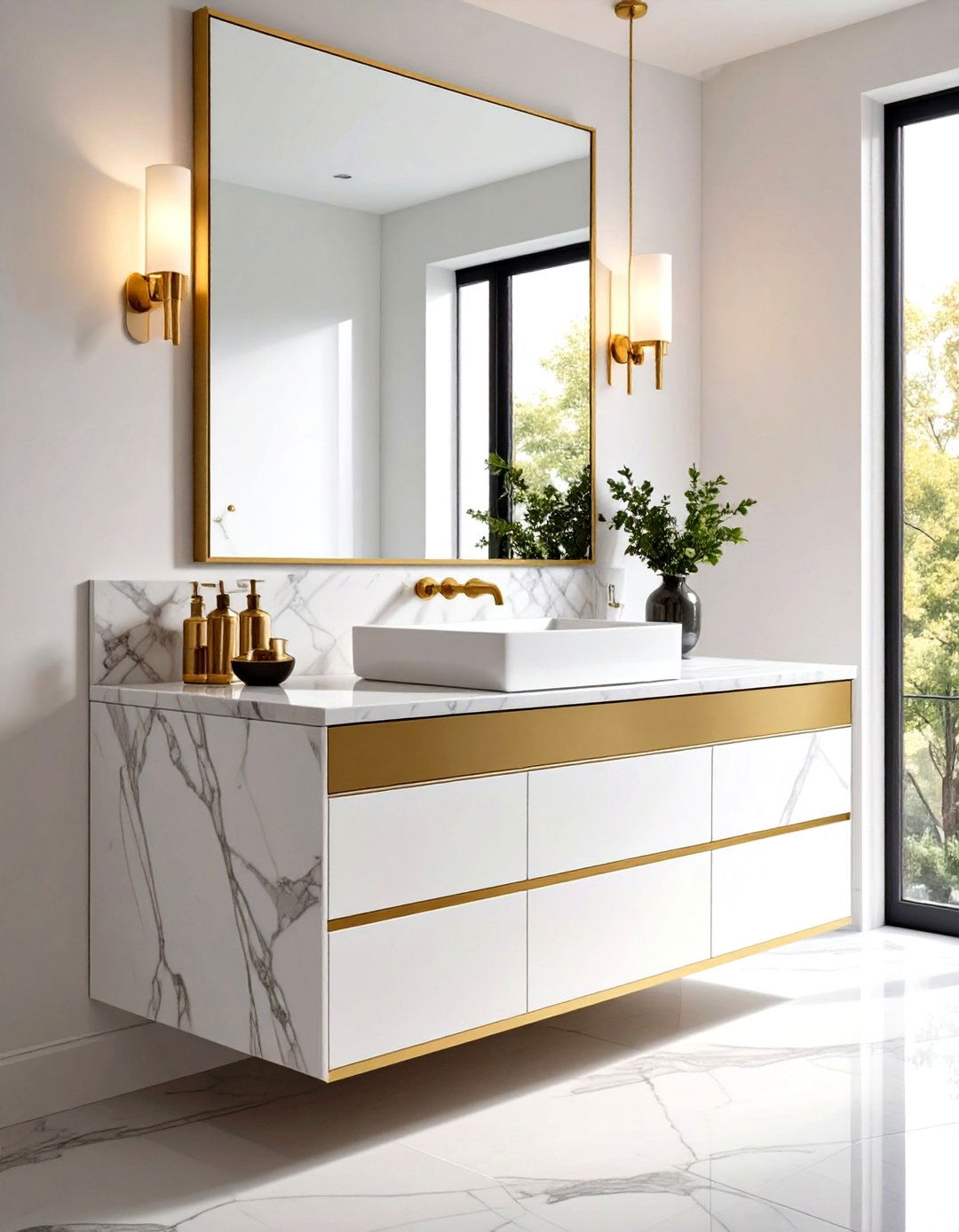
Marble vanity tops marry luxury with practicality, providing a durable, water-resistant surface that celebrates natural veining. Calacatta gold, Carrara, and Statuario are popular choices, each offering distinct patterns and shades. A floating marble vanity enhances the room’s openness, while an integrated basin carved from the same slab creates a seamless aesthetic. Maintenance involves periodic sealing to protect against etching, but the payoff is a luminous surface that elevates morning routines. Pair marble tops with matte black or brushed gold fixtures for contemporary contrast, or choose antique brass for a vintage-inspired touch.
3. Pebble Stone Flooring
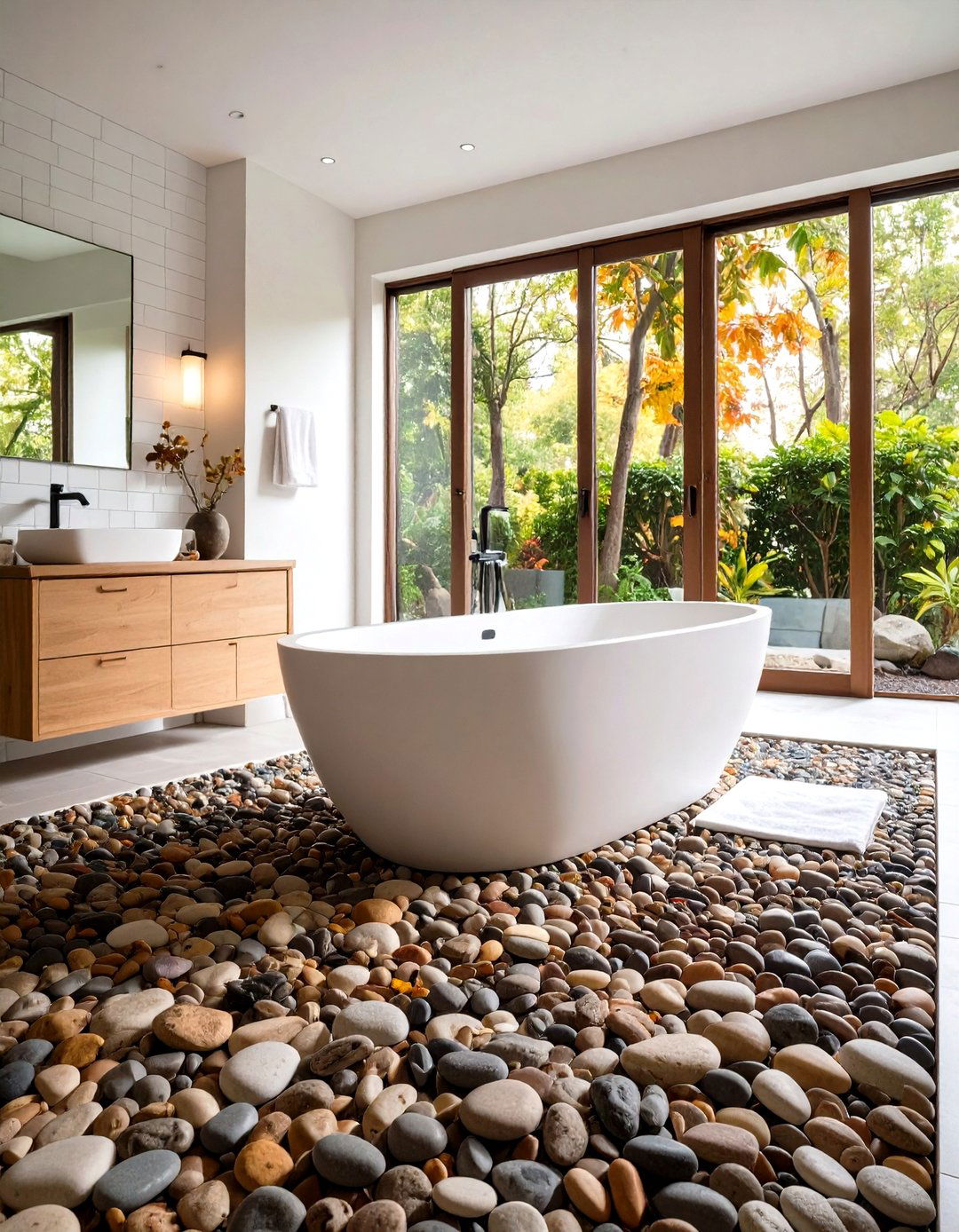
Pebble stone flooring evokes a spa-like ambiance, with smooth river stones laid into mortar for a gentle foot massage underfoot. This tactile surface works well in wet areas like showers or around freestanding tubs, as the natural undulations promote drainage and grip. Select monochromatic pebbles for a serene, cohesive feel, or mix shades of gray and beige for visual interest. Proper sealing prevents mold growth in grout lines, and regular cleaning maintains the stones’ natural luster. Complement pebble floors with simple, white subway tiles on walls to let the floor be the star, ensuring a balanced and relaxing environment.
4. Slate Tiles for Floor and Wall
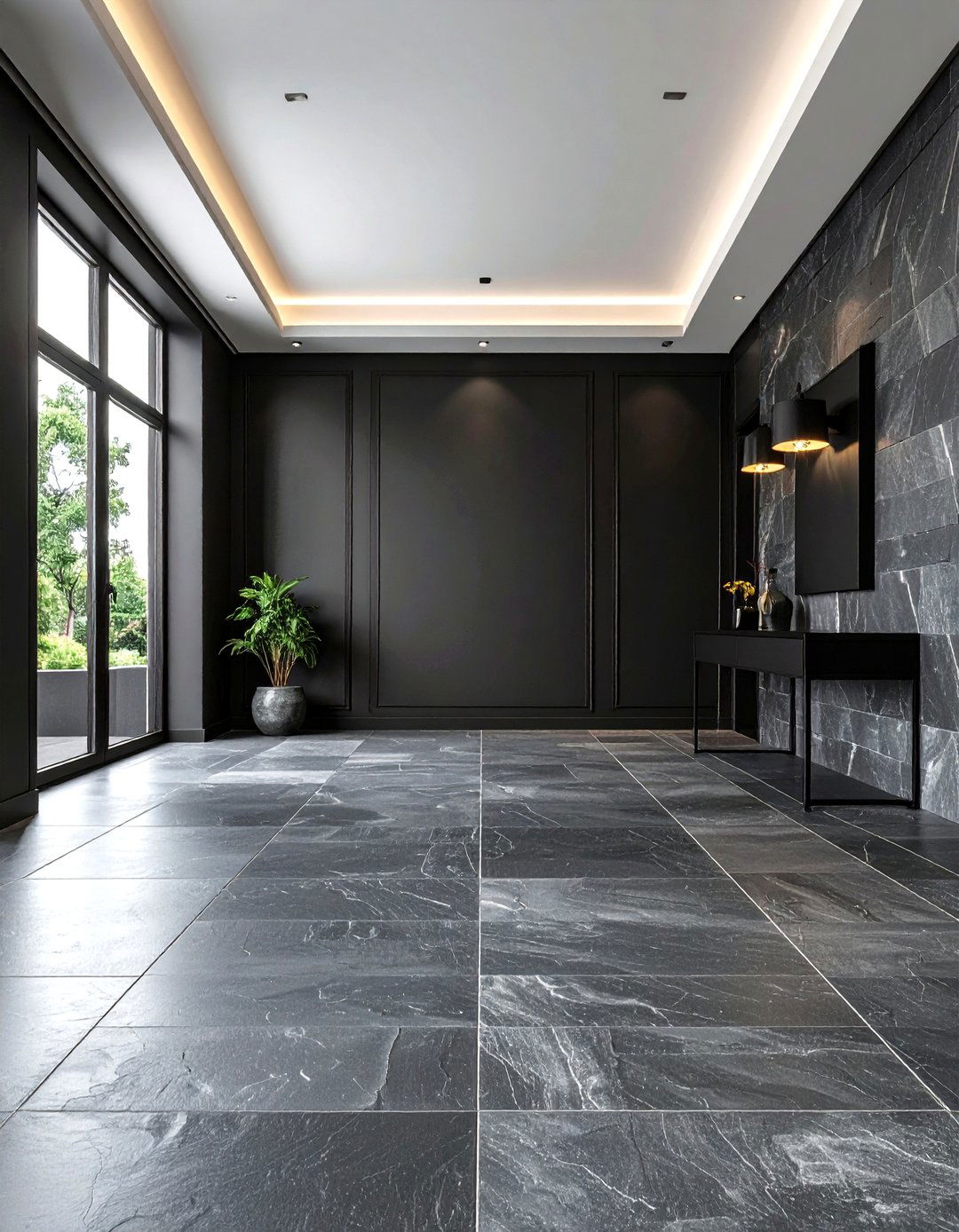
Slate tiles offer rugged beauty and durability, ideal for both floors and walls in bathrooms striving for an organic aesthetic. With hues ranging from deep charcoal to rust, slate brings warmth and character. Textured finishes enhance slip resistance, making slate a practical flooring choice, while thinner tiles can clad walls for a seamless, cave-like effect. Slate pairs beautifully with warm wood accents and matte black fixtures, creating a balanced contrast. Because slate can be porous, selective sealing is essential to prevent staining. When maintained properly, slate surfaces can last decades, maturing gracefully over time.
5. Travertine Shower Surround

Travertine’s natural veining and warm tones lend a classic, Mediterranean vibe to shower surrounds. Honed travertine tiles create a soft, velvety feel, while tumbled varieties impart a more rustic texture. Large-format travertine slabs minimize grout lines, enhancing the shower’s sleek appearance. Pairing travertine with frameless glass doors ensures the stone remains the centerpiece. Complementary niches or benches carved from matching travertine bring cohesion. To guard against moisture, choose drains that align with travertine’s slope and apply regular sealant treatments. This timeless material ages gracefully, developing an appealing patina that tells the story of everyday use.
6. Granite Countertops
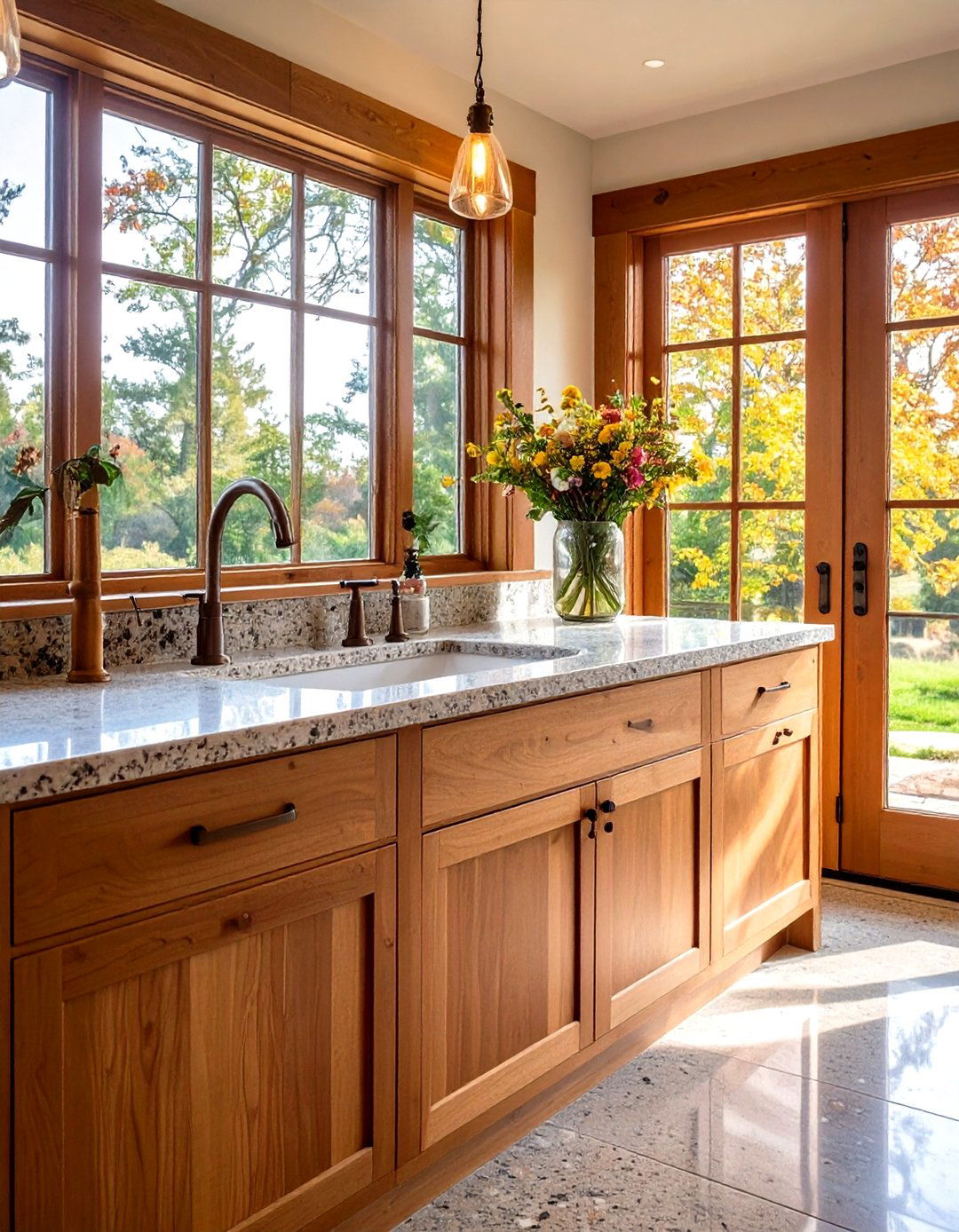
Granite countertops offer unparalleled hardness and stain resistance, making them ideal for busy bathrooms. Available in a spectrum from light salt-and-pepper patterns to deep blacks with gold flecks, granite can suit any palette. Polished surfaces reflect light, brightening smaller bathrooms, whereas leathered finishes showcase natural grain while hiding wear. Integrate undermount sinks to maintain clean lines and protect edges. Pair granite counters with wooden vanities for warmth or with sleek floating units for a modern twist. Periodic sealing ensures longevity, while granite’s density resists scratches and chips even in high-traffic family bathrooms.
7. Limestone Bathtub Surround
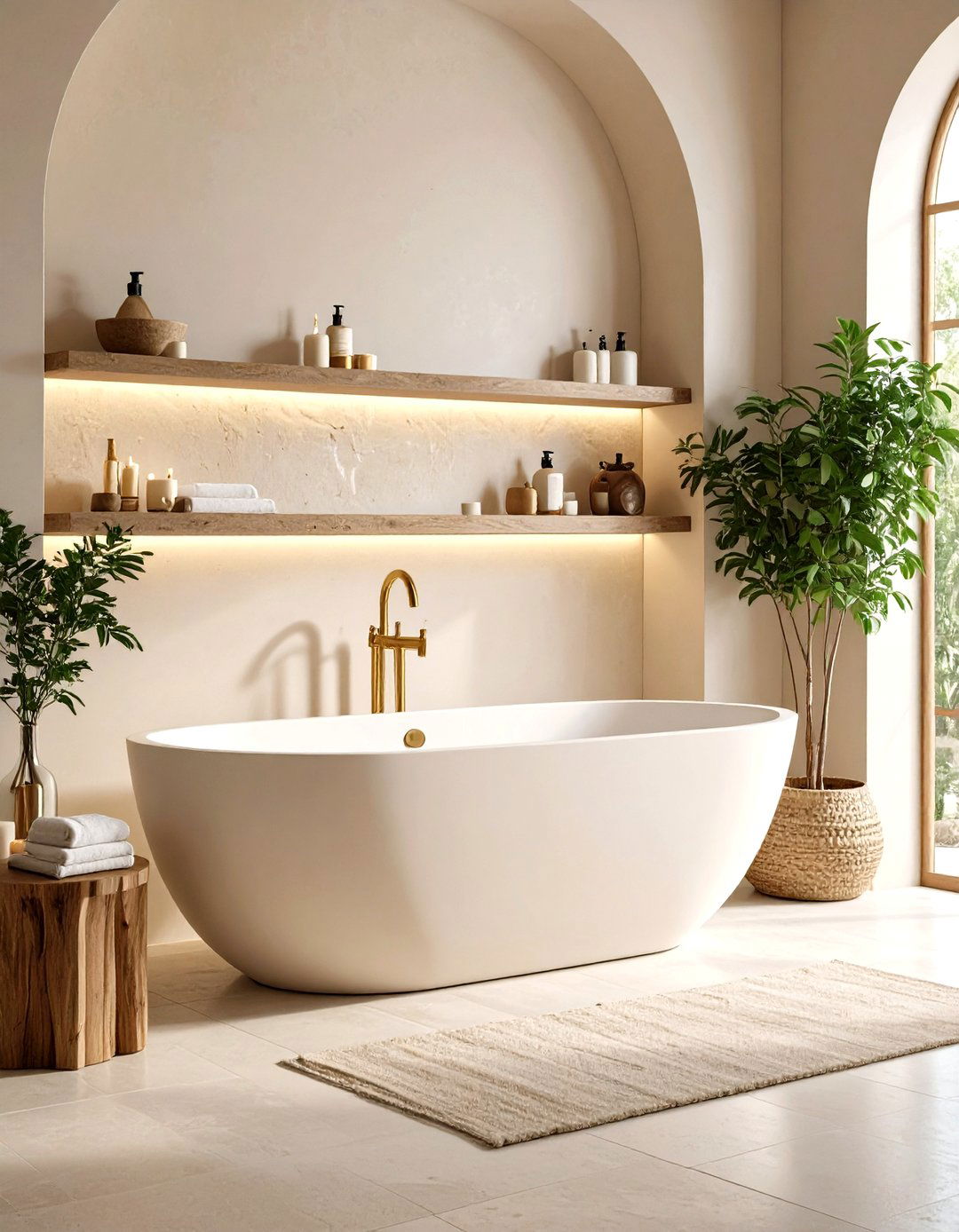
A limestone surround around a freestanding or built-in bathtub creates a serene, monochromatic retreat. Soft beige and cream hues impart spa-like tranquility, while the stone’s matte surface feels warm to the touch. Carve shelves or recessed niches into the limestone walls for functional storage without interrupting the material’s flow. Combine with brass fixtures to introduce subtle warmth, or choose chrome for a cooler palette. Limestone is naturally porous, so thorough sealing and gentle cleaners prevent staining. Over time, the stone develops a gentle patina, reflecting the bathroom’s unique character and usage.
8. Stone Mosaic Backsplash

Stone mosaic backsplashes offer intricate patterns and color variation, perfect for accents behind vanities or as a decorative band in wet areas. Mix marble, travertine, and slate tesserae for a dynamic, multicolored effect, or choose a single stone type for uniform elegance. Herringbone, chevron, or arabesque layouts add visual movement. Mosaic sheets simplify installation, ensuring consistent spacing. Pair with solid stone countertops to balance the composition. Seal mosaics to guard against moisture penetration, and use contrasting grout to emphasize patterns. This detail work transforms even compact bathrooms into curated galleries of craftsmanship.
9. Mixed Stone Textures
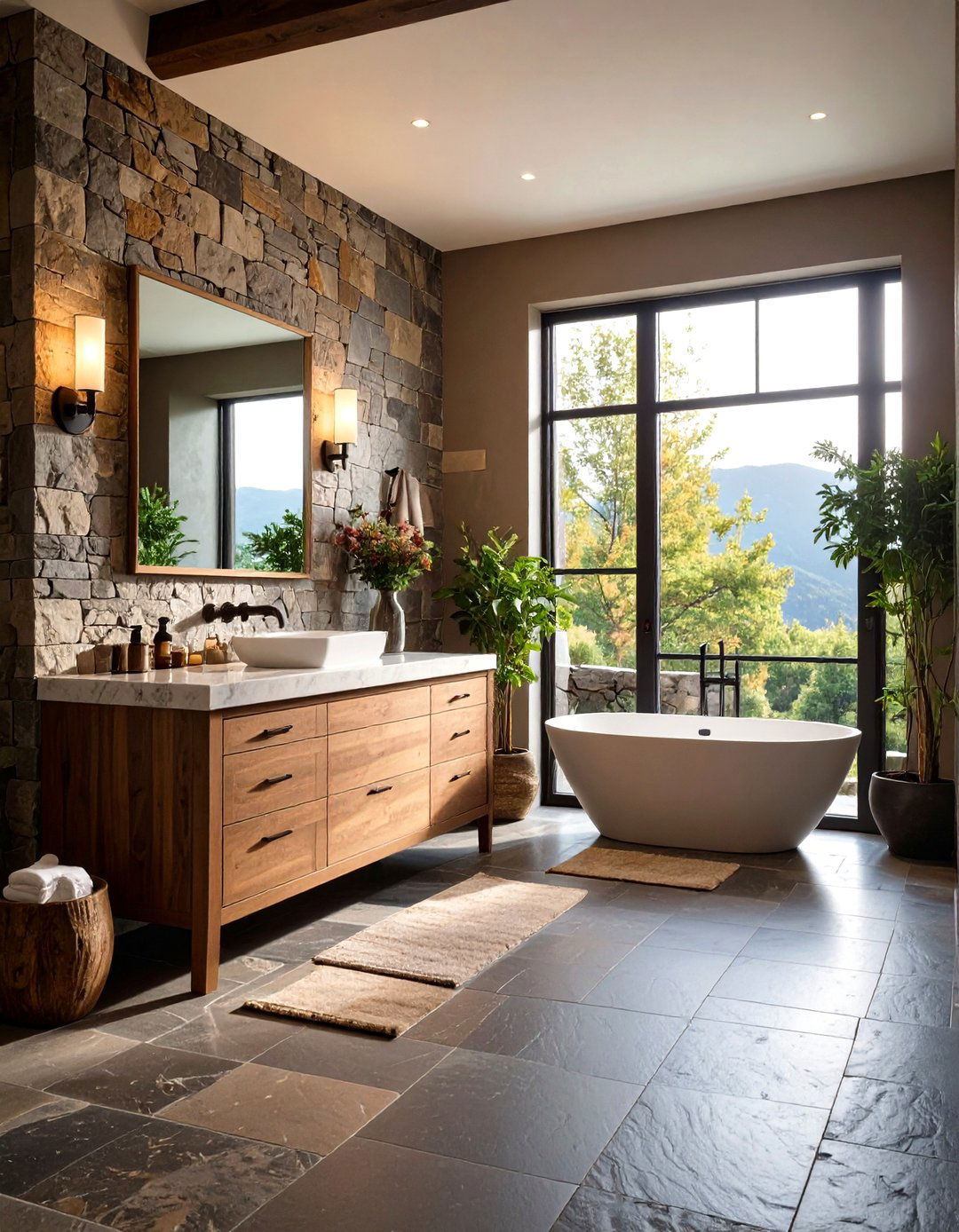
Combining multiple stone textures in one bathroom introduces depth and interest. For instance, use honed limestone on main walls, polished marble for countertops, and rugged slate on the floor. The contrast between smooth and textured surfaces enriches the sensory experience. Anchor the design with a stone-clad shower niche or feature wall that unifies disparate materials through consistent color tonality. To maintain harmony, limit stone types to three and repeat key hues across surfaces. Thoughtful transitions—such as transitioning from large slabs to small mosaics—ensure cohesion while showcasing each stone’s unique properties.
10. Honed vs. Polished Stone Finishes
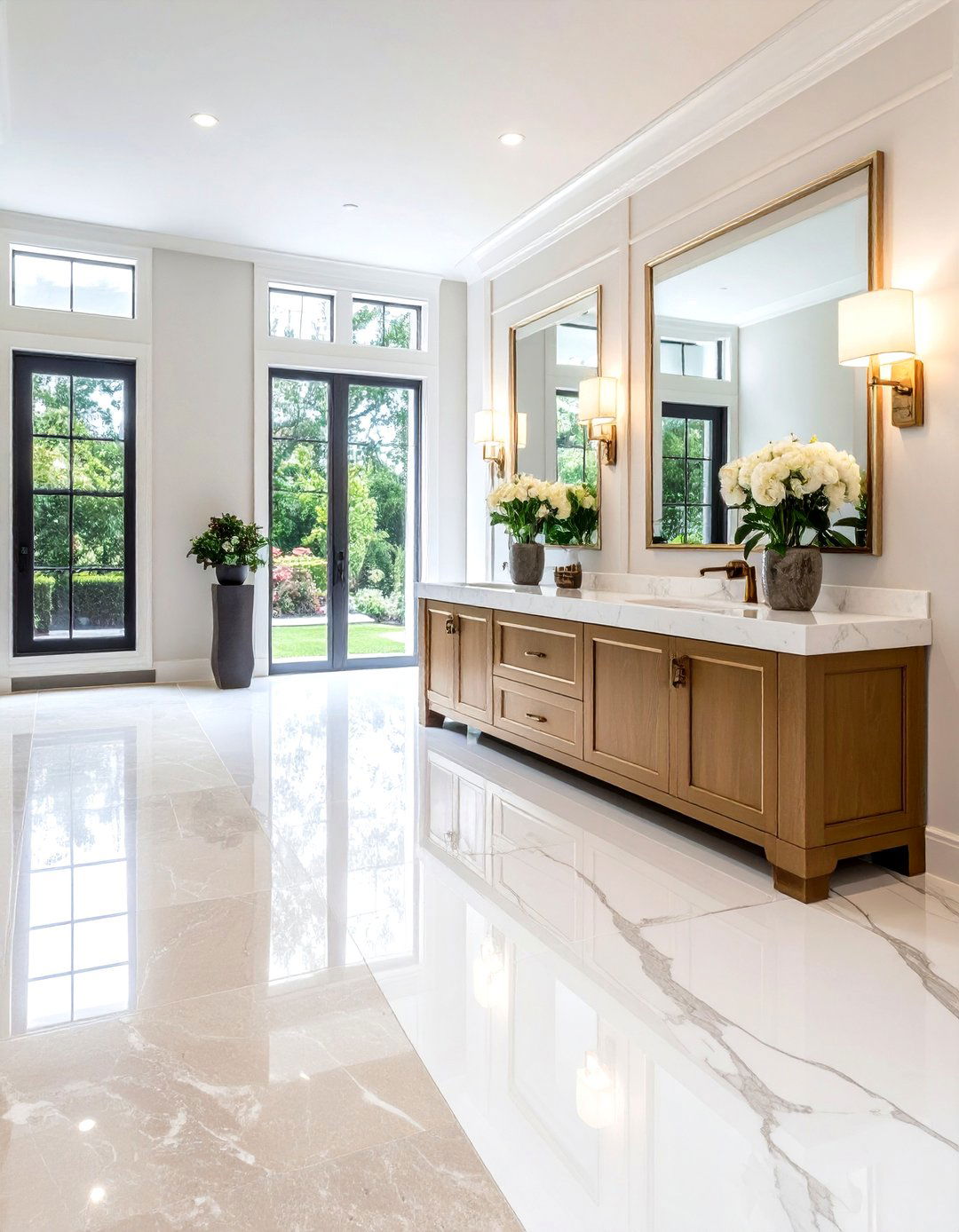
Choosing between honed and polished finishes dramatically alters stone’s appearance and feel. Honed surfaces are matte and soft, lending understated elegance and better hiding water spots—ideal for floors. Polished finishes are glossy, amplifying color and veining for maximum drama—best reserved for walls or vanity tops. In wet zones, honed stones provide added slip resistance, whereas polished stone adds luxurious shine in dryer areas. Designers often mix both: honed limestone for flooring and polished marble for accent walls, creating a deliberate interplay of light reflection and texture. Regular maintenance tailored to each finish ensures longevity.
11. Stone and Wood Combination
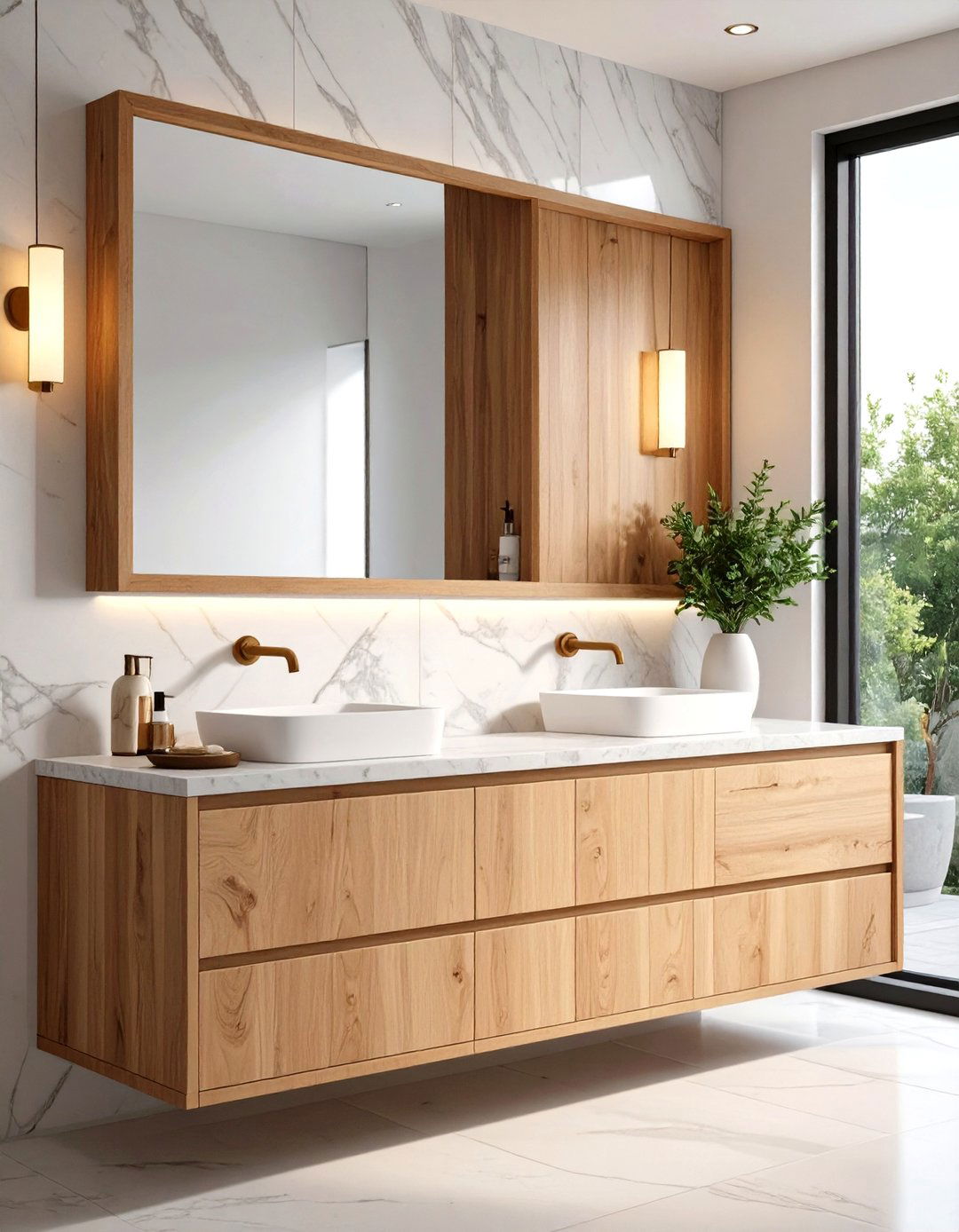
Pairing stone with warm wood elements balances natural coolness with inviting tones. A wood-framed mirror above a stone backsplash softens the hard surfaces, while a wooden vanity base complements granite or marble tops. Wood shelving integrated into stone-clad niches offers functional display with organic appeal. Ensure wood is properly sealed against humidity to prevent warping. Light woods like ash or oak contrast beautifully with darker stones, whereas rich walnut pairs with lighter marbles for a sophisticated palette. This combination works equally in rustic cottages and sleek urban lofts, delivering timeless warmth.
12. Monochromatic Stone Palette
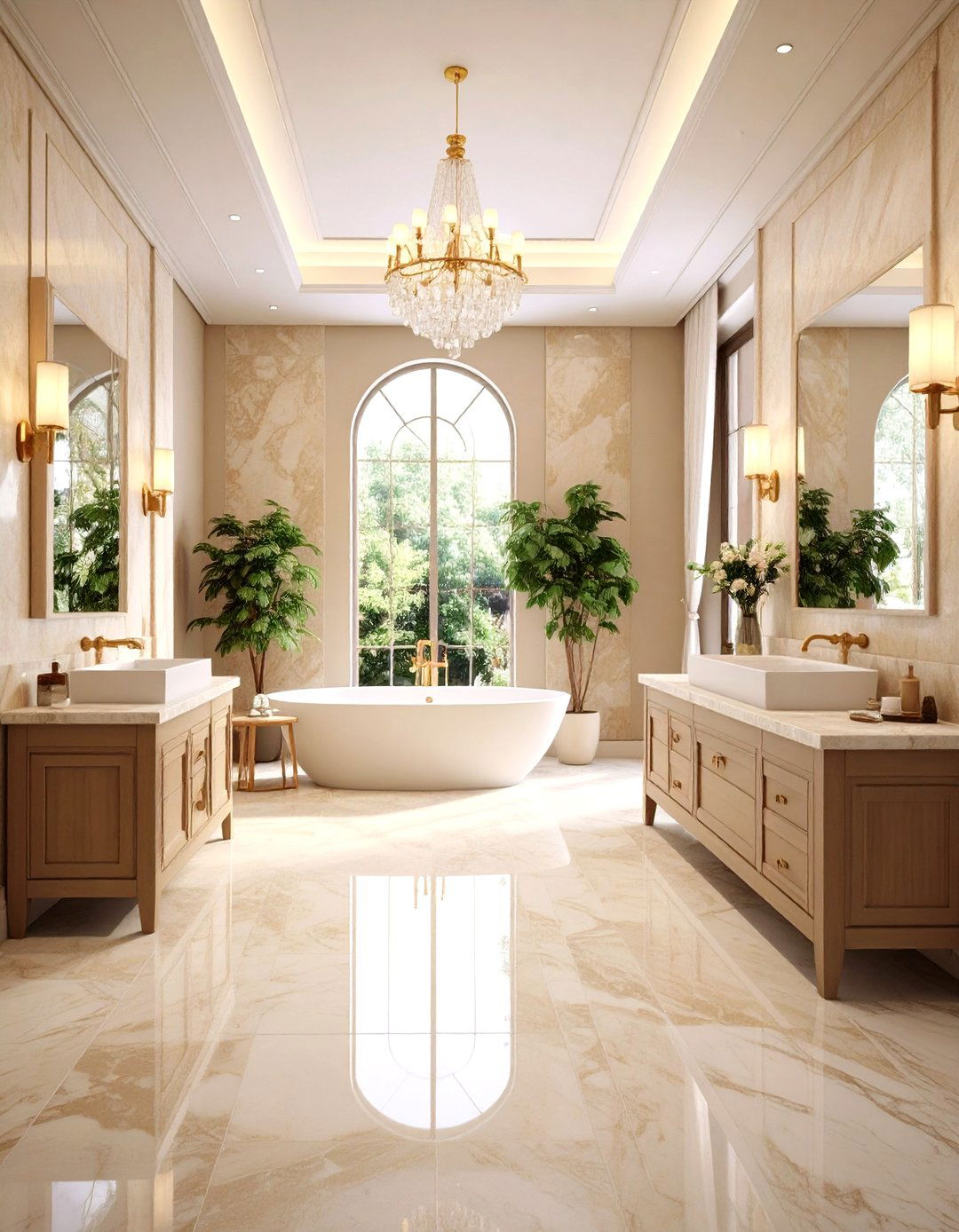
A monochromatic stone scheme—using varying shades of the same stone—creates a serene, cohesive space. For example, select ivory and beige marble or gray and charcoal slate for flooring, walls, and accents. This uniformity unclutters the visual field, yielding a spa-like aesthetic. Incorporate subtle pattern shifts—such as veined vs. solid slabs—to avoid monotony. Accessories and fixtures in matching metal tones maintain the calm palette. Monochromatic stone bathrooms feel larger and more tranquil, ideal for retreats focused on relaxation and minimalism.
13. Large-Format Stone Slabs

Large-format stone slabs minimize grout lines, emphasizing uninterrupted veining and color. These oversized panels, often used for countertops or wall cladding, create a seamless, gallery-like appearance. Bookmatched slabs on opposing walls produce dramatic mirror-image patterns. Installation requires precise handling and sturdy substrates due to the slabs’ weight. When used behind freestanding tubs or as shower walls, large-format slabs foster an immersive, high-end feel. Pair with minimal hardware to let the stone’s natural beauty dominate.
14. Rustic Fieldstone Feature
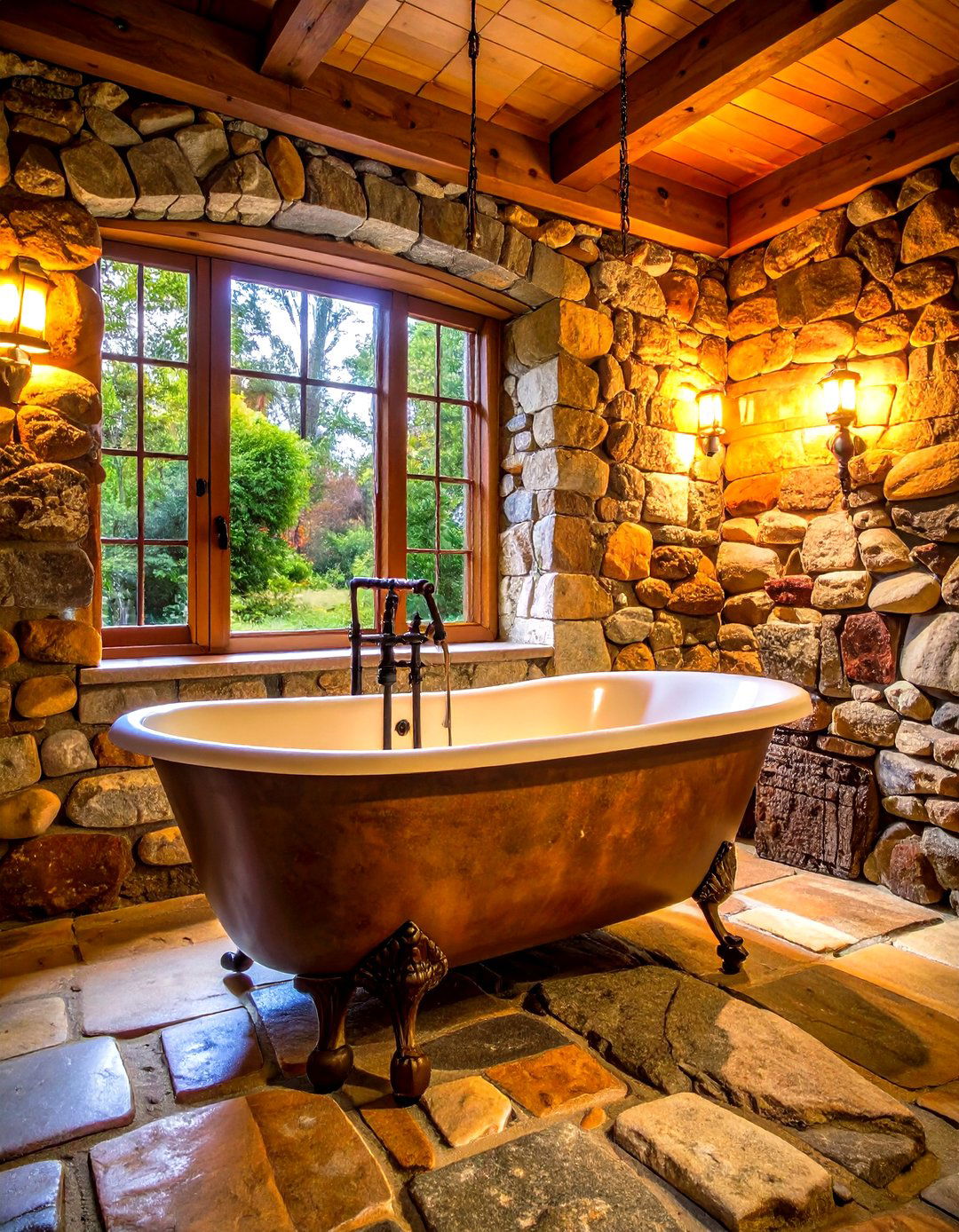
Incorporating rustic fieldstone brings an earthy, lodge-inspired charm. Rough-hewn stones stacked for a feature wall behind a claw-foot tub evoke old-world craftsmanship. The irregular surface casts dynamic shadows, enriching ambience. Contrast fieldstone with sleek, modern fixtures to balance rustic and contemporary. This look pairs well with wood-beamed ceilings and wrought-iron accents. Given fieldstone’s porosity, sealing prevents moisture infiltration, and integrated LED uplighting highlights the stone’s rugged texture. Ideal for mountain retreats or country homes, fieldstone grounds the design in natural authenticity.
15. Tumbled Stone Tiles
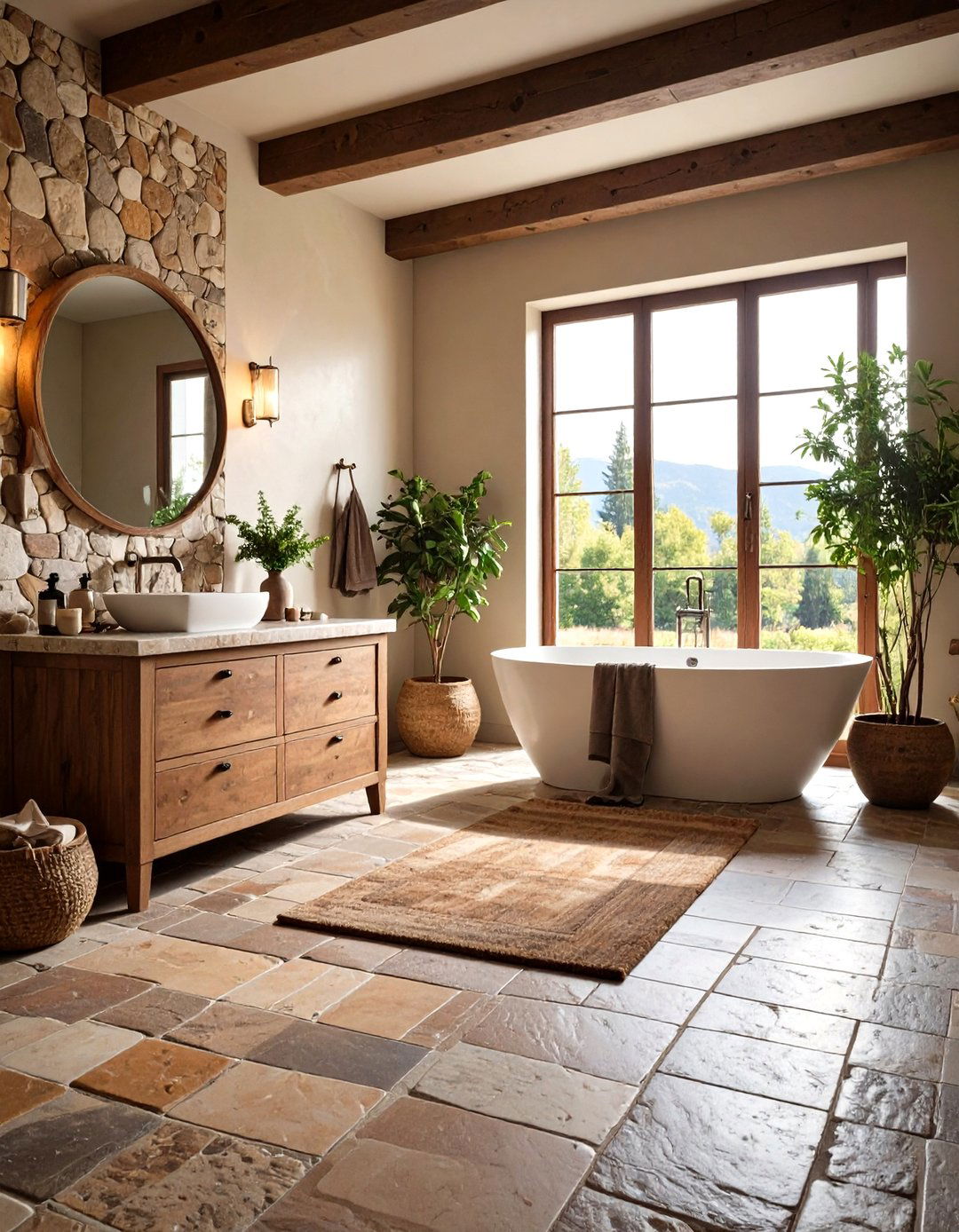
Tumbled stone tiles—where edges are softened through tumbling—offer a vintage look with subtle texture. Commonly made from travertine or marble, these tiles work well on floors and walls, providing slip resistance and visual warmth. Available in varied sizes, they fit well in mosaics or basketweave patterns. Pair tumbled tiles with straight-edged modern fixtures for an appealing juxtaposition. Proper sealing is critical to protect against moisture and staining. Over time, tumbled tiles develop character through gentle wear, ideal for bathrooms aiming for lived-in charm.
16. Stone Vessel Sink
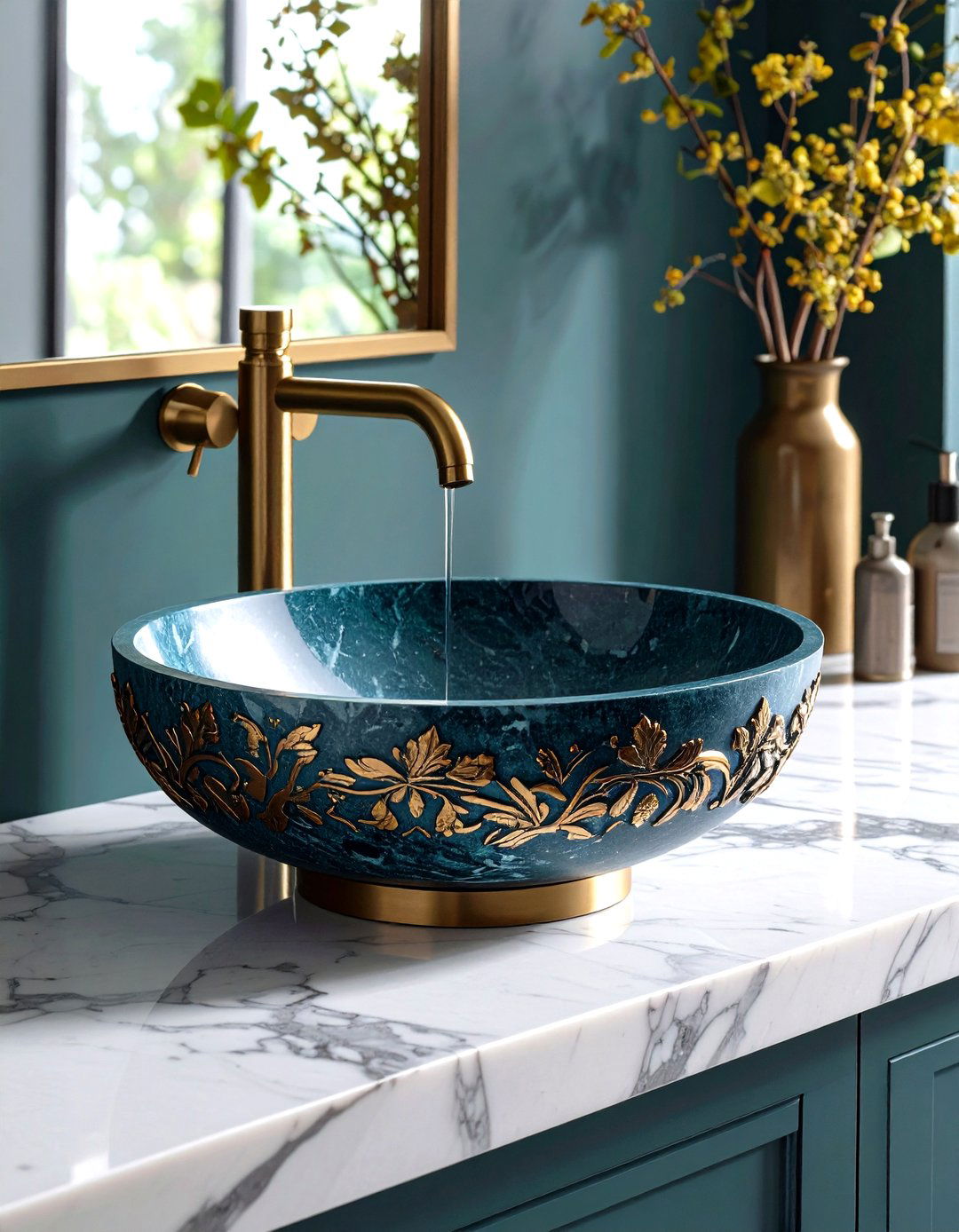
A stone vessel sink serves as a sculptural focal point, introducing organic form and texture. Hand-carved basins from marble, onyx, or sandstone sit atop vanities, showcasing the stone’s unique patterns. Coordinate faucet heights and spouts to clear the rim without splashing. The sink’s thickness and weight necessitate a sturdy countertop substrate. Pair with minimalist fixtures to let the sink’s artistry shine. Vessel sinks demand regular sealing to prevent water marks, but they reward with museum-quality presence in any bathroom design.
17. Stone Fireplace in Bathroom

In larger bathrooms, a stone-clad fireplace adds dramatic warmth and luxury. Surround the hearth with stacked stone or large limestone blocks, creating a cozy focal near a freestanding tub or seating area. Ensure that fireplace materials meet building codes for wet environments. Complement with plush textiles and wood accents to enhance the retreat-like atmosphere. A fireplace transforms a bathroom into a holistic spa space, blending warmth, texture, and architectural interest into a singular sanctuary.
18. Stone Thresholds and Door Surrounds

Stone thresholds and door surrounds make subtle yet impactful details, framing transitions between bathroom and adjoining spaces. A strip of marble or granite at the doorway signals a shift in materiality. Thicker slabs used as jambs evoke classical architecture. These elements protect high-traffic edges while elevating entryways. Coordinate stone types with flooring or vanity materials for seamless flow. This refinement underscores attention to detail, turning even functional transitions into opportunities for design cohesion.
19. Recessed Stone Shelving and Niches
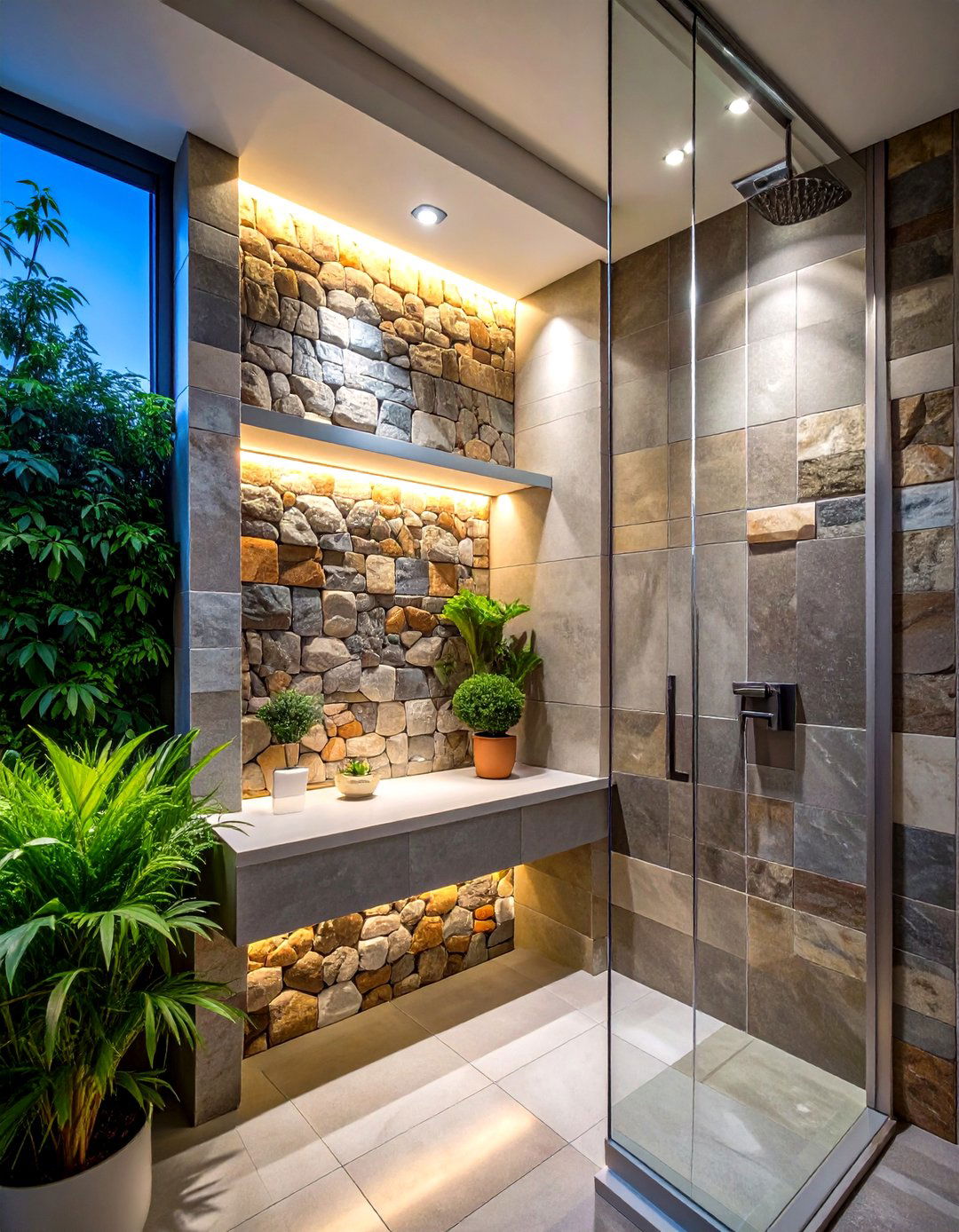
Recessed niches carved into stone shower walls or beside bathtubs provide functional storage without disrupting clean lines. Line the niches with contrasting stone mosaic or match surrounding slabs for a seamless look. Integrated LED strips in the niches add drama and practical lighting. These built-in features keep toiletries organized while highlighting stone’s versatility, making every alcove an intentional design moment.
20. Backlit Onyx Feature Wall

Backlit onyx transforms bathrooms into ethereal spaces, with the stone’s translucence illuminated from behind. Onyx slabs in honey, green, or white emit a soft glow, ideal for accent walls or vanity backdrops. Installation involves routing channels for LED fixtures and securing thin onyx panels to a stable backing. The result is a jewel-like installation that melds art and architecture. Given onyx’s delicacy, handle with care, but the luminous effect creates an unforgettable focal point that elevates any bathroom into a work of art.
Conclusion:
Stone offers boundless possibilities in bathroom design, from rugged fieldstone to delicate onyx illumination. By selecting appropriate materials, finishes, and installation methods, you can create spaces that blend functionality with artistry. Whether emphasizing natural textures, playing with light in backlit features, or combining stone with wood and metal, these 20 strategies demonstrate stone’s versatility and enduring appeal. Thoughtful sealing and maintenance preserve beauty over time, ensuring your stone bathroom remains a timeless sanctuary.


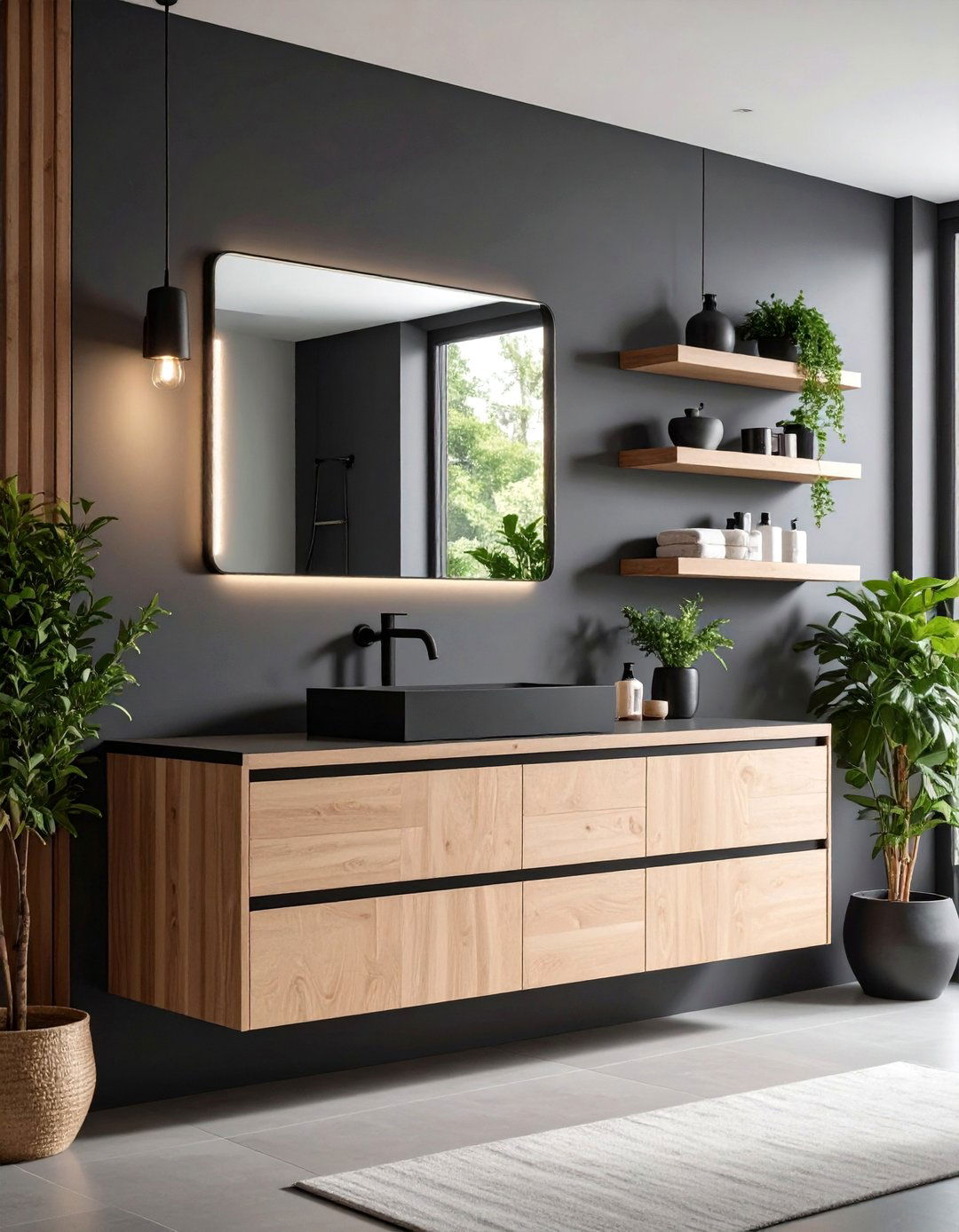
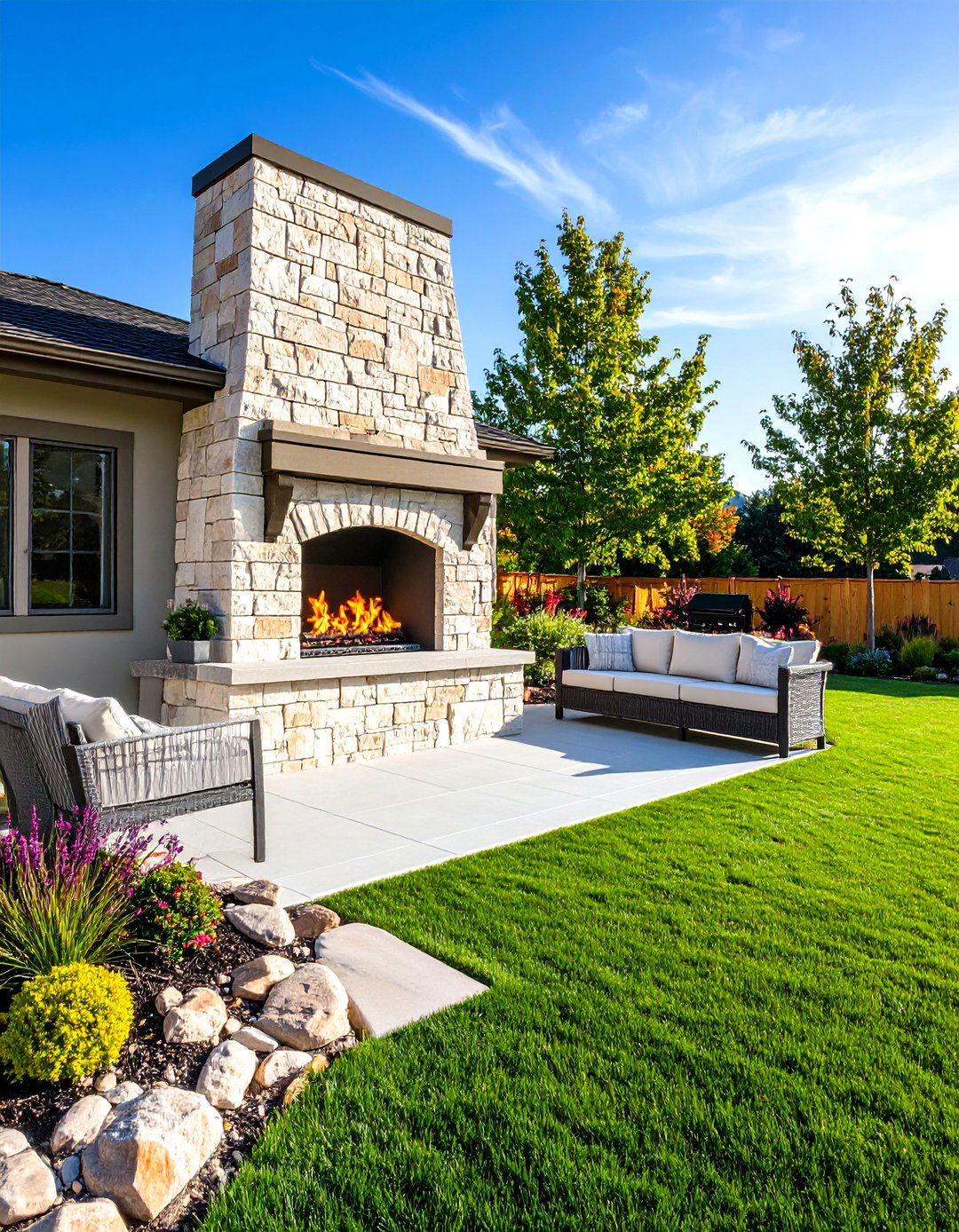
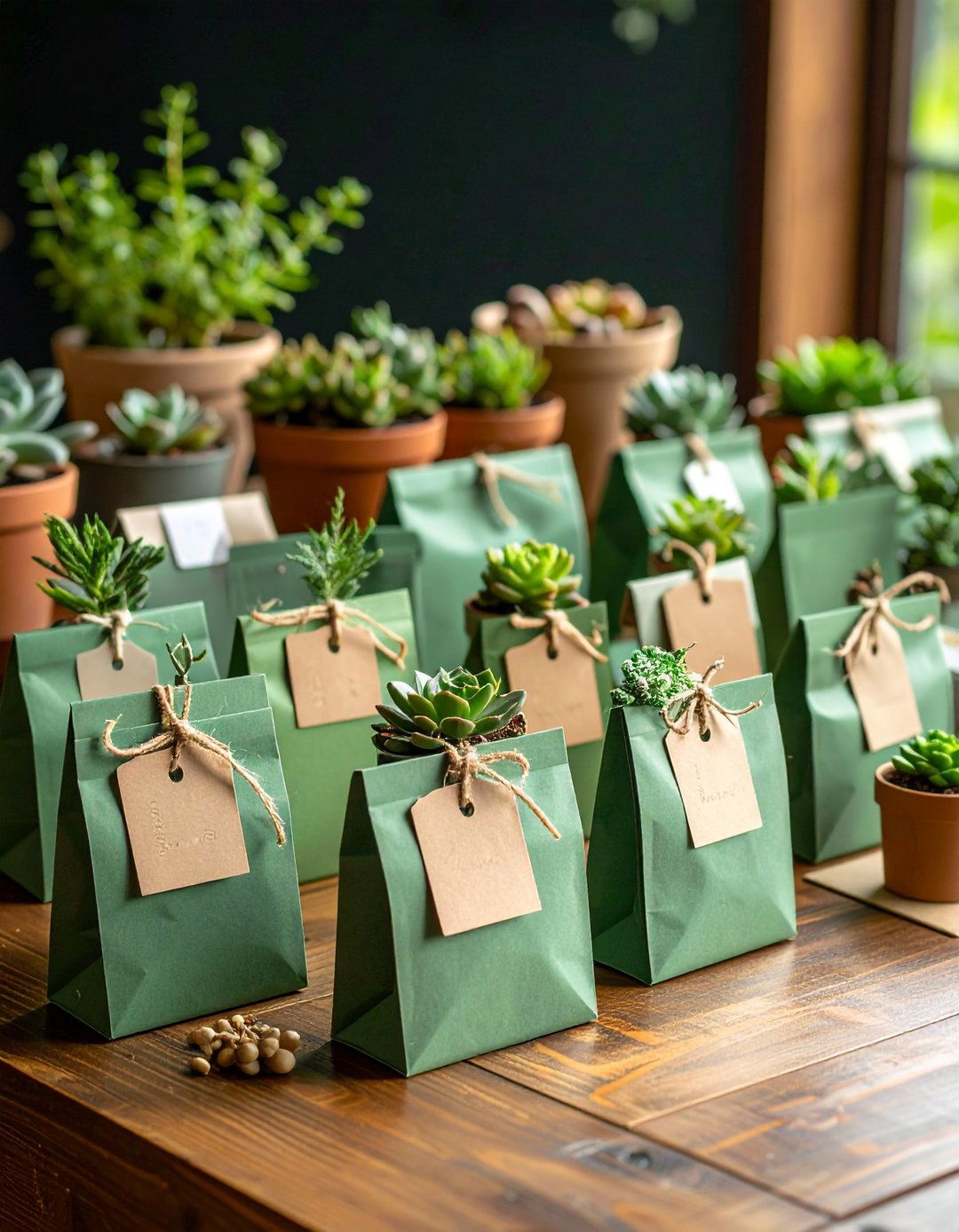
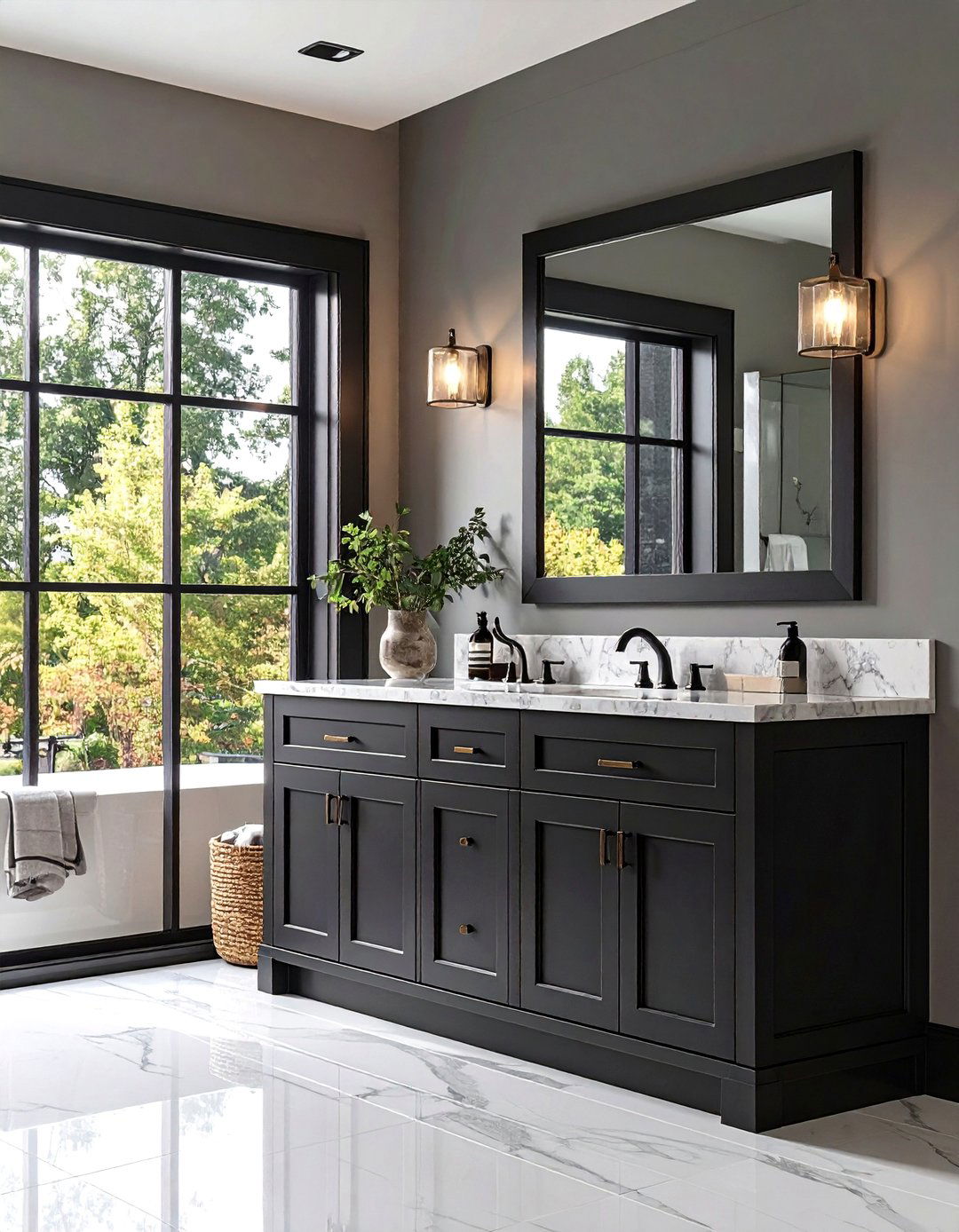
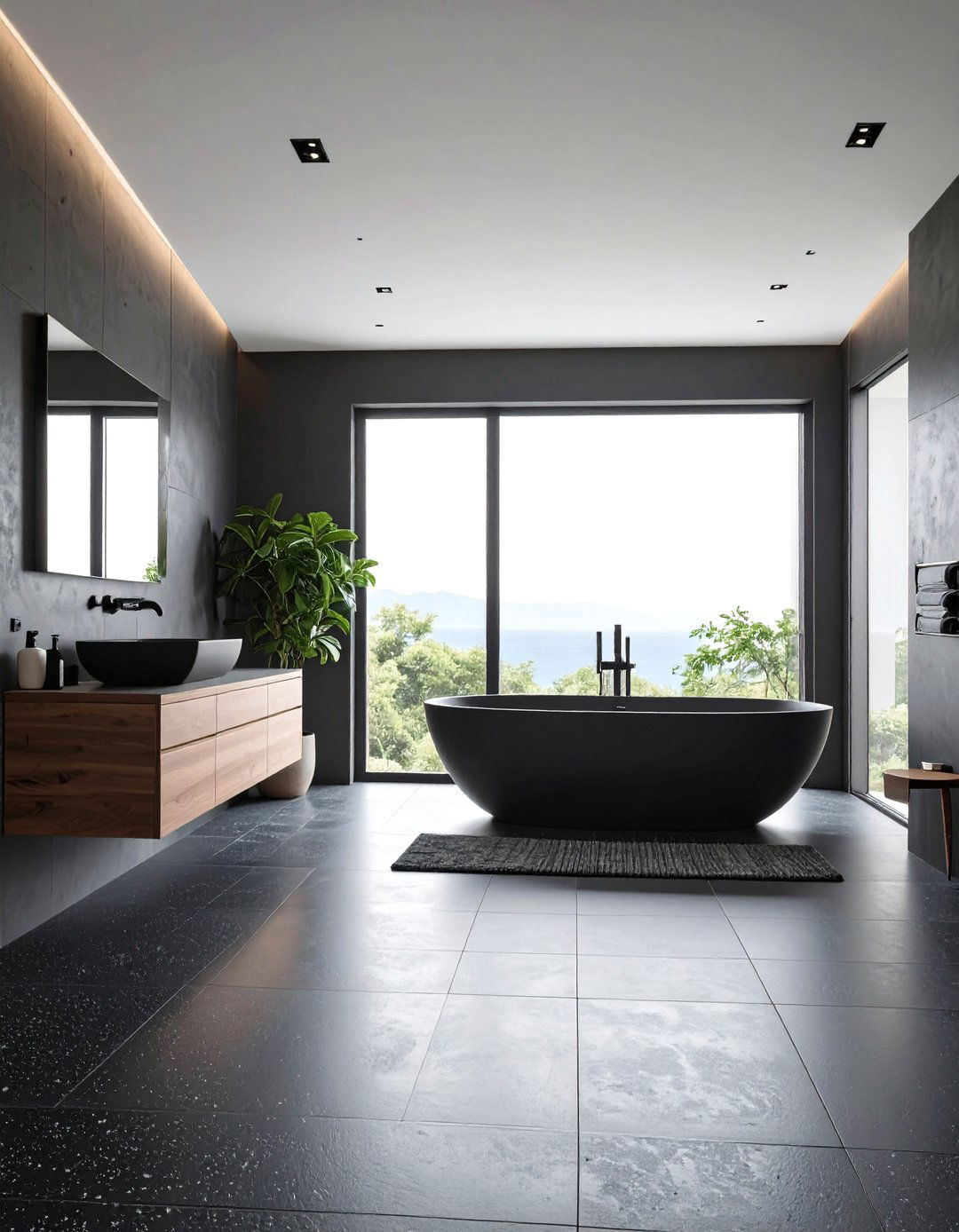


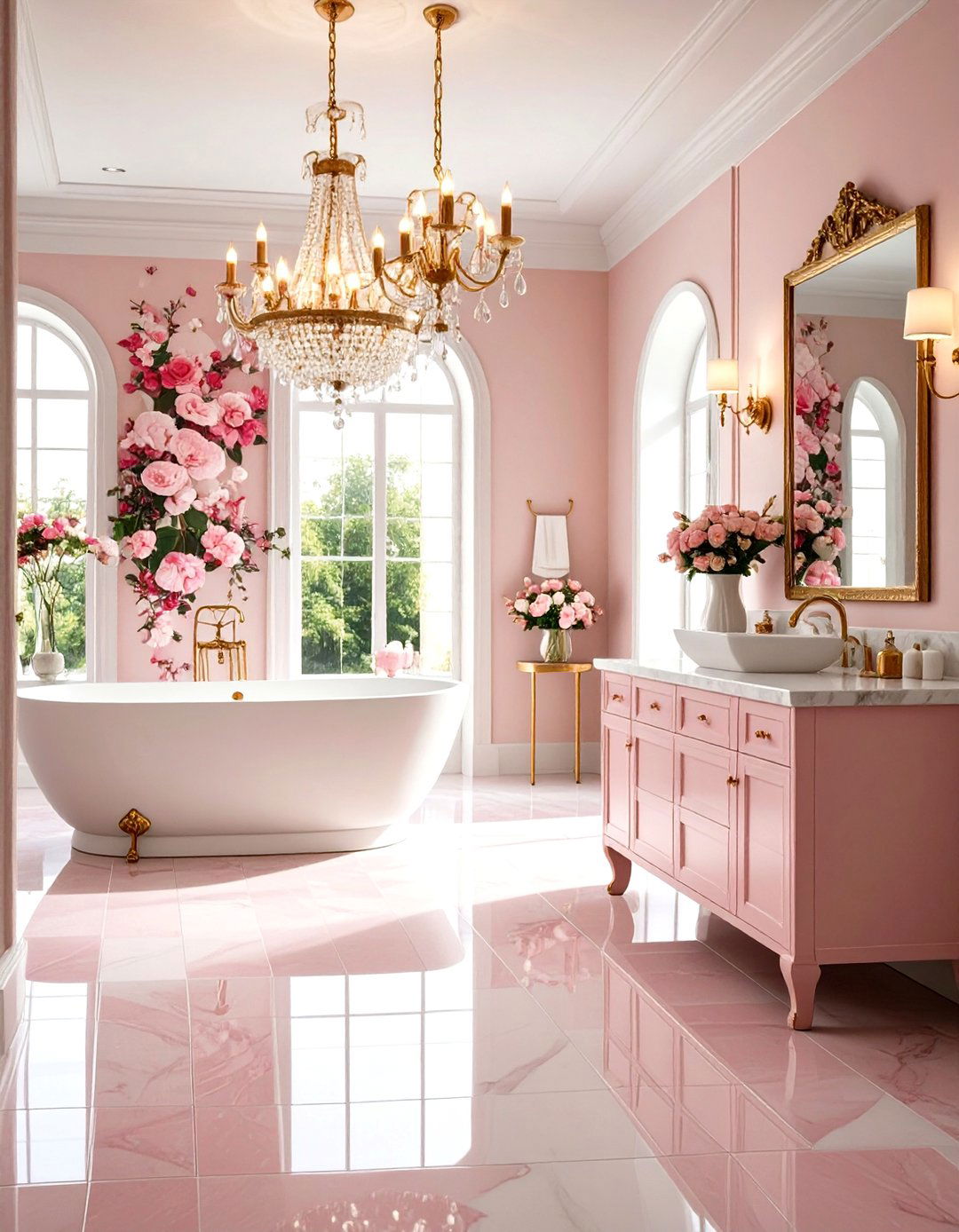

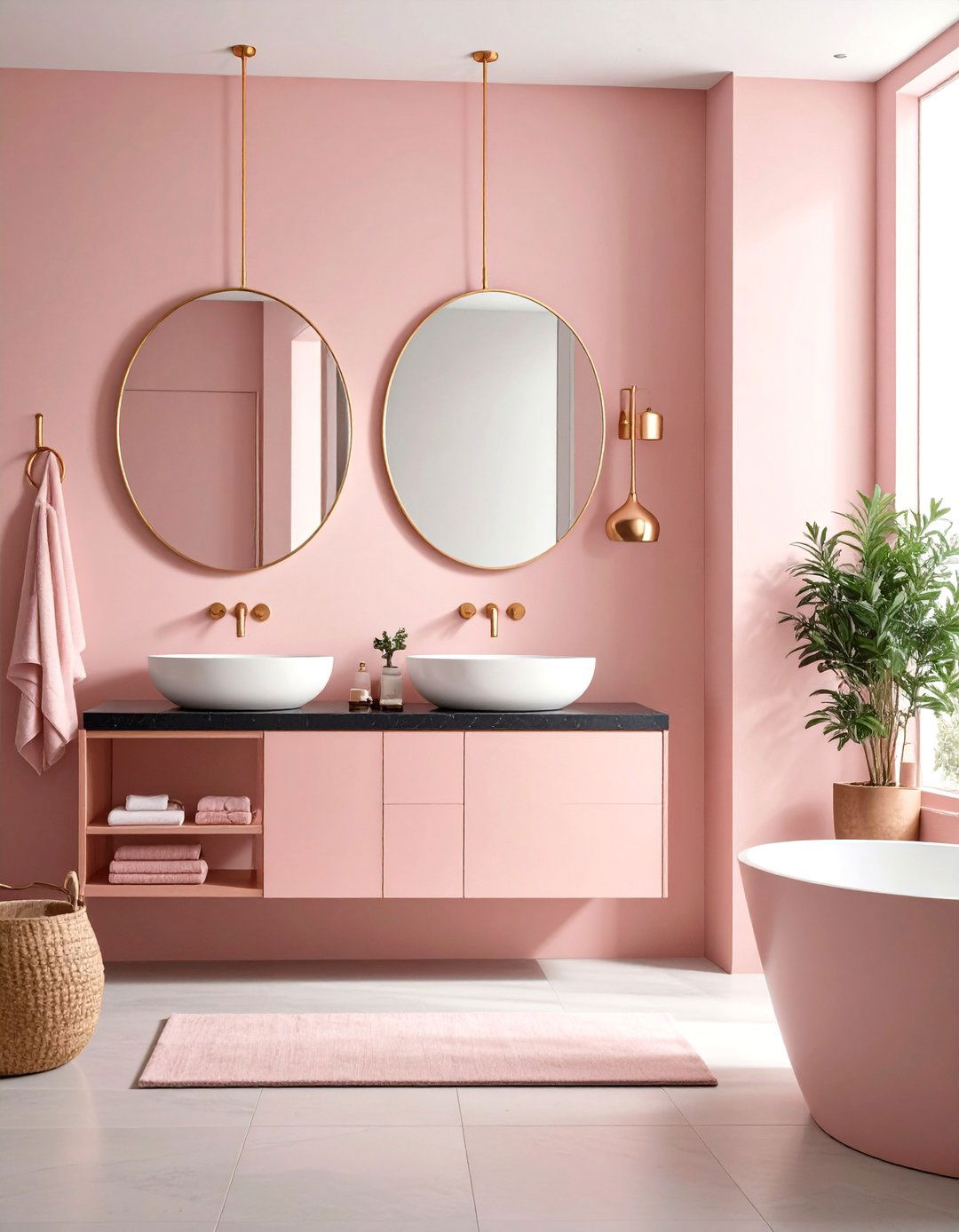
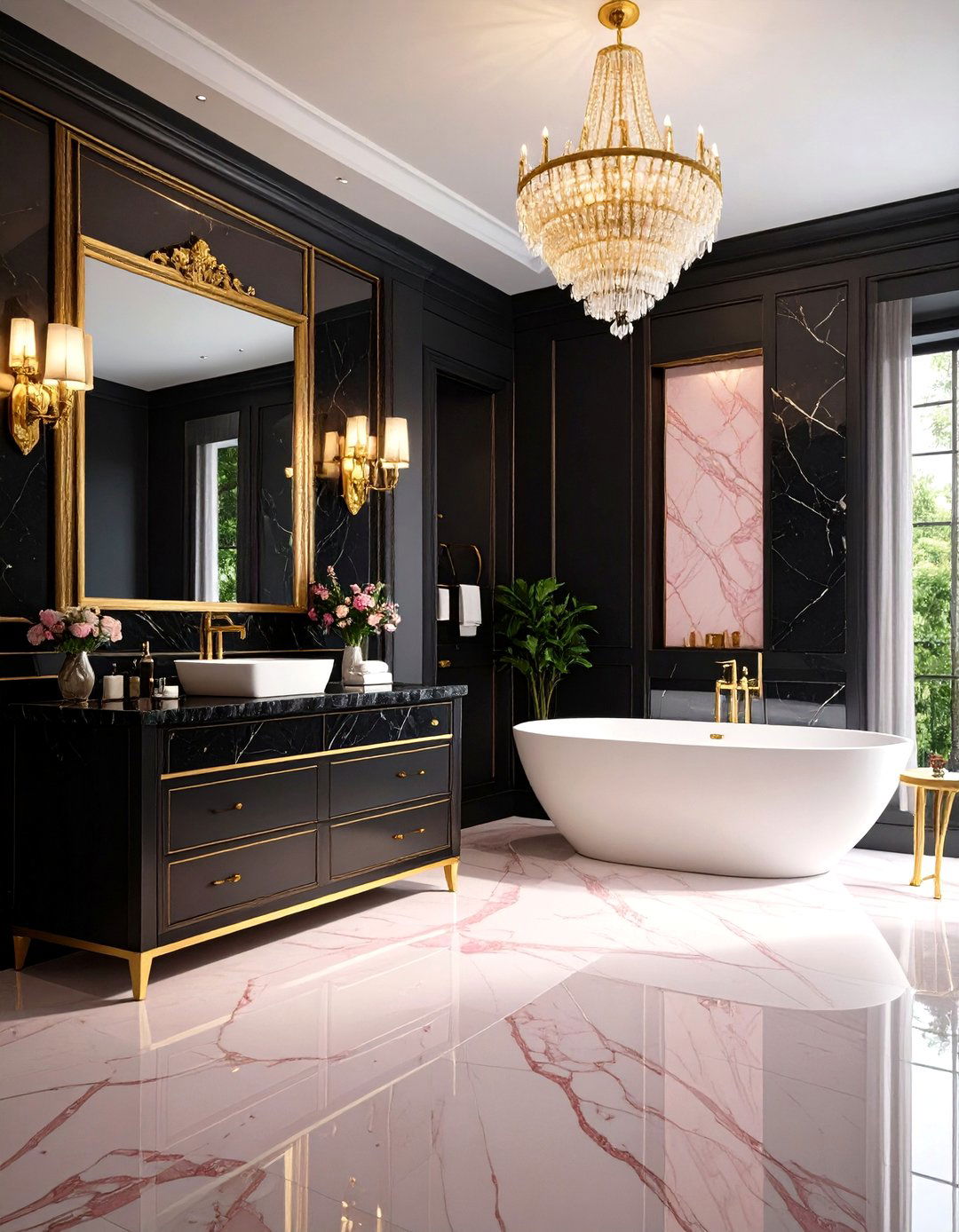
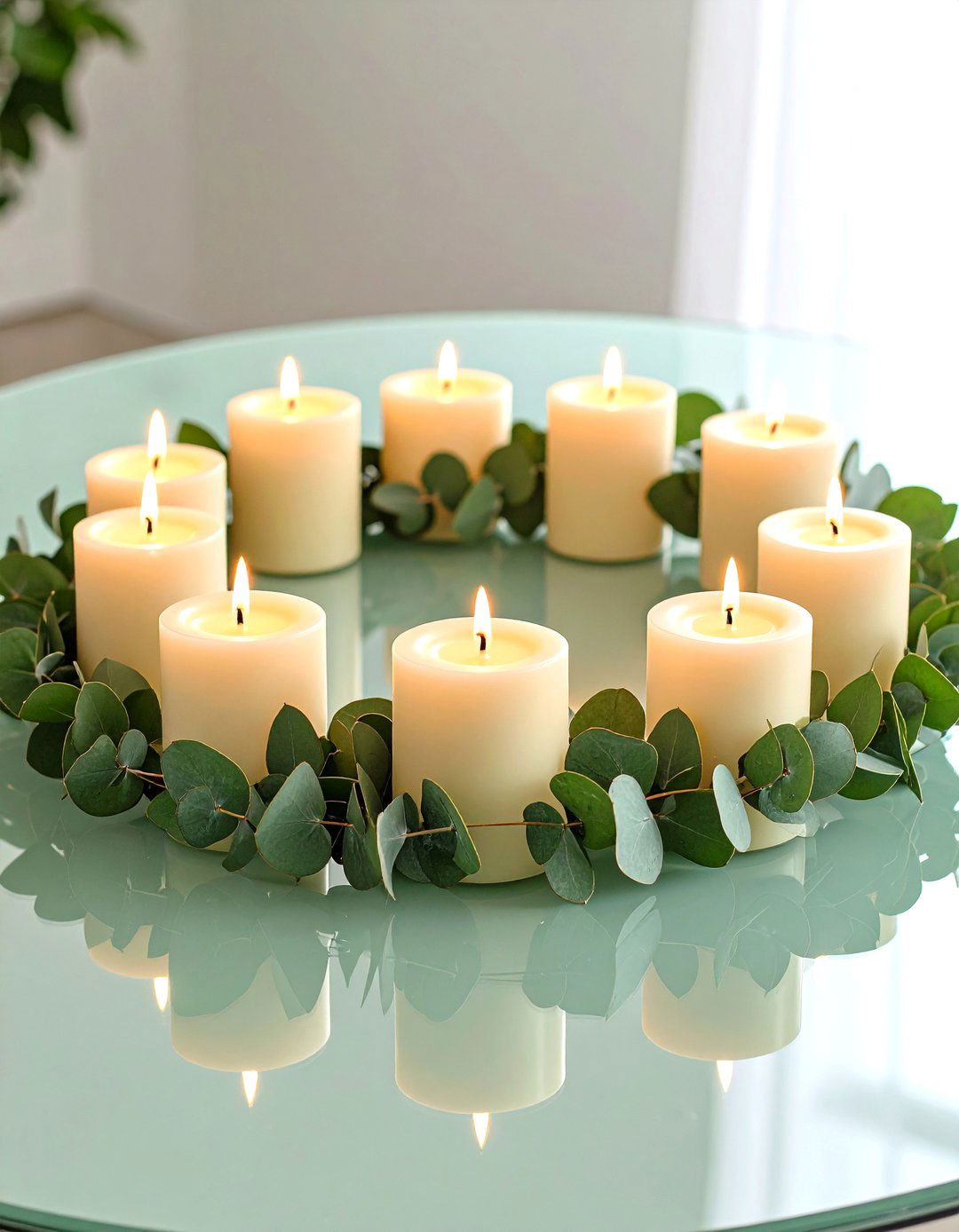
Leave a Reply